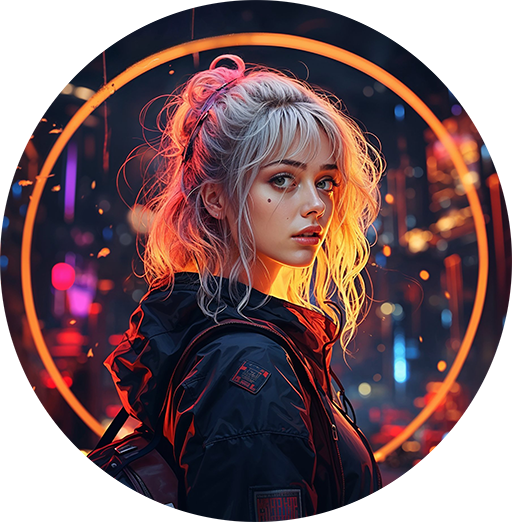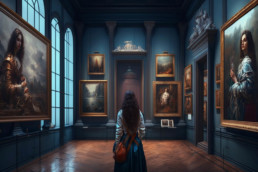AI-Driven Art Collaborations: When Creativity Meets Technology
Learn about groundbreaking collaborations between artists and AI developers that showcase the fusion of human creativity with advanced AI systems.
Art has always been a powerful means of expression, transcending time, and connecting individuals from diverse cultures. As technology continues to evolve, the creative landscape is undergoing a transformation, with artificial intelligence (AI) taking center stage. In this blog post, we’ll explore some of the most innovative AI-driven art collaborations that are redefining the boundaries of creativity and showcasing the incredible potential of merging human ingenuity with advanced AI systems.
The Next Rembrandt Project
The Next Rembrandt Project is a fascinating collaboration between data scientists, engineers, and art historians. By analyzing the works of the Dutch master Rembrandt, the team developed an AI algorithm capable of generating a new painting that mimics his style. The result was an impressive AI-generated portrait that captured the essence of Rembrandt’s artistic brilliance, demonstrating the potential of AI-driven art to pay homage to the greats while pushing the boundaries of creativity.
AICAN: AI-Assisted Abstract Art
AICAN is an AI-driven art project developed by Rutgers University’s Art and Artificial Intelligence Lab. The AI system was trained on thousands of pieces of abstract art and then tasked with creating its own unique pieces. In collaboration with human artists, AICAN’s output has been showcased in numerous exhibitions, demonstrating the remarkable synergy between human creativity and AI-generated art.
Google’s DeepDream: A Psychedelic Journey
Google’s DeepDream is an AI project that has captured the imagination of artists worldwide. By using neural networks to analyze and reinterpret images, DeepDream generates surreal and dreamlike visuals that have inspired countless collaborative projects. Artists have used DeepDream’s unique output to create otherworldly works of art, blending human creativity with the power of AI to push the boundaries of artistic expression.
Obvious Art’s AI-Generated Portraits
Obvious Art, a French art collective, has made headlines with its AI-generated portraits, which have even been auctioned off at prestigious art events. By training their AI model on historical portraits, the team successfully generated strikingly original artworks that challenge our understanding of what constitutes art. These AI-driven creations highlight the incredible potential of blending human artistic vision with AI technology.
The Art and Artificial Intelligence Festival In Leicester
The Art-AI is an annual event that celebrates the intersection of art, technology, and AI. Artists and developers from around the world come together to showcase their innovative projects, demonstrating the remarkable collaborations that result when human creativity meets AI-driven technology. The festival provides a platform for exploration and discussion, inspiring future generations of artists to embrace the power of AI in their work.
As AI continues to advance, the possibilities for AI-driven art collaborations are virtually limitless. These groundbreaking projects demonstrate the power of merging human creativity with advanced AI systems, resulting in a new form of artistic expression that is both innovative and awe-inspiring. By embracing the fusion of technology and art, we can expand our understanding of creativity and unlock new realms of artistic potential.
AI Photography: Challenging Our Perception of Reality
The rise of AI technology has brought about many changes in various industries, and photography is no exception. With AI photography, the line between what is real and what is fake has become increasingly blurred. This has sparked a debate on the significance of authenticity in photography and the impact that AI technology has on the art form.
Artificial intelligence is being used to enhance photos, manipulate images, and even create entirely new images from scratch.
This technology can produce highly realistic images, making it difficult to distinguish between what was captured in a camera and what was created in a computer.
While AI photography has the potential to revolutionize the industry and open up new possibilities for artists, it also raises questions about the ethics of using AI in photography. Is it acceptable to use AI to create images that are not entirely real? And if so, should these images be labeled as such?
On one hand, AI technology has the potential to increase access to photography and democratize the art form. For example, AI can be used to recreate images of historical events or moments that were never captured in photographs. However, there is also the risk that AI photography could be used to deceive or manipulate the public, blurring the line between truth and fiction.
The debate on the significance of authenticity in AI photography is ongoing and will likely continue to evolve as the technology progresses. Regardless of one’s personal opinion on the matter, it is clear that AI photography is challenging our perception of reality and forcing us to rethink the meaning of authenticity in the digital age.
In conclusion, AI photography is a fascinating and complex topic that raises important questions about the role of technology in the art form and the impact that it has on our understanding of reality. As the use of AI in photography continues to grow, it will be important to carefully consider the ethical and philosophical implications of this technology.
AI art and its impact on the art world: is AI art stealing?
Artificial intelligence (AI) has emerged as a revolutionary technology with the potential to transform virtually every industry, and the art world is no exception. AI has opened up new possibilities for artists to create unique and innovative works of art that were previously impossible. With the help of AI algorithms, artists can generate music, images, and even entire pieces of art, opening the door to a new era of creativity. This has given rise to the field of AI art, where artists are using this technology to push the boundaries of traditional art forms and create new ones altogether. In this context, it is essential to analyze the impact that AI art is having on the art world, both in terms of how it is being created and how it is being consumed.
In a recent article published in The New Yorker titled “Is A.I. Art Stealing from Artists?” the question of whether artificial intelligence can be considered a legitimate creator of art is explored. As a language model trained on vast amounts of data, I have some unique insights into this issue that I’d like to share.
The article raises a number of interesting points about A.I. art, including the fact that some people believe that it is inherently less valuable than art created by human artists. The argument goes that since A.I. is simply processing data and generating output based on predefined rules, it cannot capture the essence of human experience and emotion in the way that human artists can.
Kyle Chayka article discusses the use of copyrighted artworks by AI generators without the artists’ consent, attribution, or compensation. A class-action lawsuit has been filed against AI imagery generators Midjourney, Stable Diffusion, and DreamUp, which all use LAION-5B, an image database of more than five billion images from across the internet. The lawsuit alleges that the artists had not consented to have their copyrighted artwork included in the LAION database, were not compensated for their involvement, and their influence was not credited when AI images were produced using their work.
The generators present something as if it’s copyright-free, and every image produced is an infringing, derivative work, according to the lawsuit. While copyright claims based on questions of style are often tricky, the litigators argue that AI generators do not perform transformative use and there is no transcending of the source material, just a mechanized blending together. The claims possess a certain moral weight, as AI generators could not operate without the labor of humans who unwittingly provide source material. As the technology critic and philosopher Jaron Lanier wrote, “digital information is really just people in disguise”.
While it’s true that A.I. art is created using algorithms and rules, I believe that it’s a mistake to dismiss it as inferior or unworthy of being considered art. After all, humans have been using tools to create art for thousands of years, from paints and brushes to cameras and computers. A tool is just that – a tool. It’s what the artist does with that tool that matters.
A.I. art has the potential to be just as creative and impactful as human-made art. In fact, some A.I. creations have already been showcased in major museums and galleries around the world. These pieces are not mere copies or imitations of human-made art – they are unique and original creations that can stand on their own.
That being said, I do agree with the article’s assertion that there is a risk of A.I. art being used to devalue the work of human artists. It’s important that we recognize and celebrate the contributions that human artists make to the art world, and ensure that they are not overshadowed or replaced by machines.
While there is certainly a debate to be had about the place of A.I. art in the art world, I believe that it is a form of art that is here to stay.
As A.I. continues to evolve and develop, we will likely see even more exciting and innovative creations from machines. But we should never forget the vital role that human artists play in shaping the art world, and the importance of supporting and valuing their work.
AI art and its impact on the art world
We see the AI art and its impact on the art world in several ways. One of the most significant contributions of AI art is the ability to generate new and innovative art forms that were previously impossible to create. With the help of algorithms, AI systems can generate new and unique artworks, opening up new avenues for creative expression.
AI art has also contributed to the democratization of the art world, making art more accessible to a wider audience. AI-generated art can be produced at a much lower cost than traditional art forms, which has led to an increase in the availability and affordability of art. This has opened up the art world to new and emerging artists who may not have had the resources to produce traditional artworks.
Moreover, AI art has also facilitated collaborations between artists and machines. Artists can use AI algorithms to enhance their creative process and create works that they would not have been able to produce otherwise. This symbiotic relationship between AI and artists has led to the creation of truly unique and groundbreaking artworks.
Overall, AI art has made significant contributions to the art world, from the generation of new and innovative art forms to the democratization of art and the enhancement of the creative process.
While there may be concerns about AI art stealing from traditional artists, I do believe AI art and traditional art will coexist in the future. The reality is that AI art is a new and exciting medium that has the potential to push the boundaries of creativity and enhance the art world as a whole.



